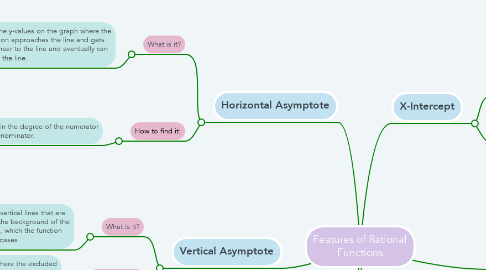
1. Horizontal Asymptote
1.1. What is it?
1.1.1. It is the y-values on the graph where the function approaches the line and gets very near to the line and eventually can cross the line.
1.2. How to find it:
1.2.1. It is found in the degree of the numerator and the denominator.
1.2.1.1. If the degree of the denominator is greater than the numerator then the asymptote is y=0
1.2.1.2. If the degree of the numerator is greater than the denominator then there is no asymptote.
1.2.1.3. If the degree is the same in both then the asymptote is the division of the leading coefficients.
2. Vertical Asymptote
2.1. What is it?
2.1.1. It is the vertical lines that are part of the background of the function, which the function never crosses
2.2. How to find it:
2.2.1. It is where the excluded values are not holes. Zeros of denominator that are not holes.
3. Slanted Asymptote
3.1. What is it?
3.1.1. A slanted line that is part of the background of the function, which the function never crosses
3.2. How to find it:
3.2.1. Divide the numerator by the denominator. If the degree of the numerator is greater than the degree of the denominator by one, there is a slanted asymptote.
4. Holes:
4.1. What is it?
4.1.1. Are the open circles in a graph that are in the place where the excluded values are. They are called removable discontinuity.
4.2. How to find it:
4.2.1. When there is a fraction in factor form, the holes are the factors that are both the same in the denominator and the numerator.
5. X-Intercept
5.1. What is it?
5.1.1. It is the point or points where the function crosses the x-axis in the graph
5.2. How to find it:
5.2.1. In a function, when not an excluded value, the zeros of the numerator are x-intercepts
6. Y-Intercept
6.1. What is it?
6.1.1. It is the point where the function crosses the y-axis in the graph
6.2. How to find it?
6.2.1. In the standard form of the function, you replace the variable with a 0, the solution is your y-intercept
